Scoville Scale Chart for Hot Sauce and Hot Peppers
Updated for 2021!
Since 2006, I've been compiling the most comprehensive list of the hottest hot sauces and hot peppers on the web. Although other websites in recent years have stolen the data here and have sprung up on the web to make a quick dollar, I will choose to make this Scoville Scale List of Chile Peppers And Hot Sauces advertisement-free.
Some of the sauce items (especially the ones in excess of one million Scoville Heat Units and hotter) below may not necessarily be "sauces" you apply directly on food - they are food additives made with a liquid chile ppeper extract and should only be used sparingly. The very highest ones are not liquid at all. These capsaicin extracts are powders or crystals, as pure capsaicin comes in crystaline form.
For more information on how the Scoville Scale for hot peppers and hot sauces is determined, read the What is the Scoville Scale article.
Chile Peppers
Name | Scoville Heat Units |
|---|---|
Pepper X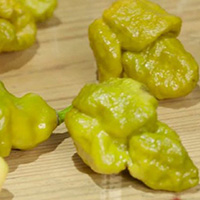 Species: capsicum chinense Pepper X is a cultivar of Capsicum chili pepper bred by Ed Currie, creator of the Carolina Reaper. Pepper X resulted from multiple cross breedings that produced an exceptionally high content of capsaicin in the locules of the pepper. The exceptional heat of the chili was developed over 10 years of cultivation. Currie stated that it is "two times as hot as the Carolina Reaper", which would make it the hottest pepper in the world with a Scoville scale of 3.18 million units, but this remained unconfirmed by the Guinness World Records as of 2019. Type: chile pepper | UNOFFICIAL 3,180,000 Scoville Heat Units [SHU] 636 times hotter than a jalapeño |
Smokin' Ed's Carolina Reaper Pepper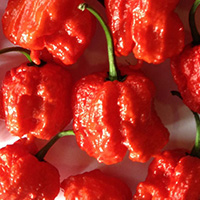 Species: capsicum chinense As of 2014, this is currently the Guinness World Record holder for World's Hottest Chile, the Carolina Reaper pepper was grown by Ed Currie of Puckerbutt Pepper Company out of South Carolina. Also known as the HB22a. In 2018, Guinness World Records re-certified the Carolina Pepper again at 1,641,000 SHU for the average amount of heat per pepper pod. Type: chile pepper | 1,641,000 - 2,200,000 Scoville Heat Units [SHU] 440 times hotter than a jalapeño |
Trinidad Moruga Scorpion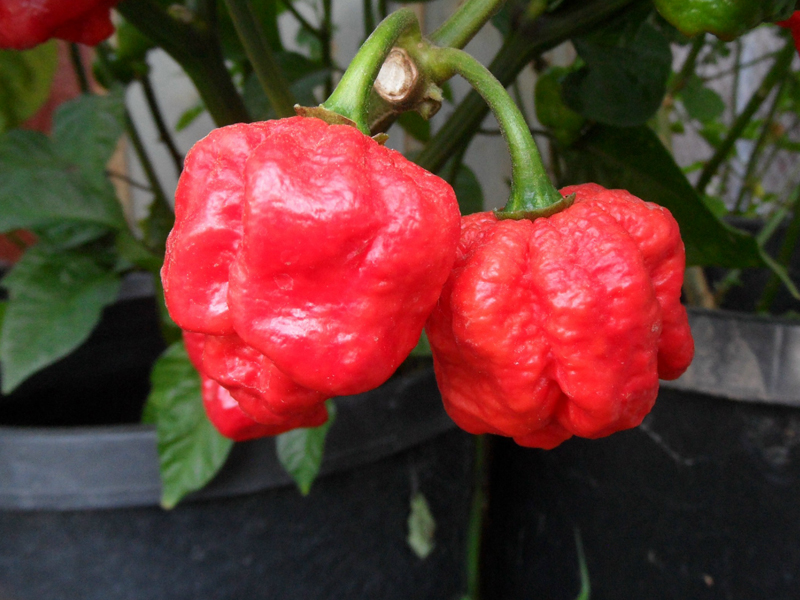 Species: capsicum chinense A superhot strain closely related to the Trinidad Scorpion Butch T. as of February 2012, it had been tested as the world's hottest chile pepper until the Carolina Reaper usurped it in November of 2013. Type: chile pepper | 580,198 - 2,009,231 Scoville Heat Units [SHU] 401.8 times hotter than a jalapeño |
7-Pot Douglah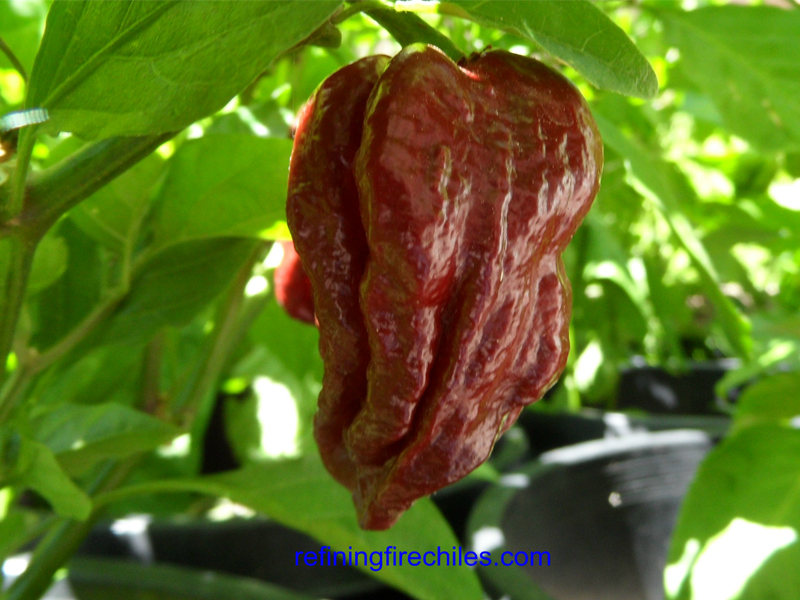 Species: capsicum chinense A version of the super-hot 7-Pot, 7 Pot Douglah, or Chocolate 7 Pod. Super-intense chile pepper that ranks up with the hottest, including the Carolina Reaper, Moruga Scorpion, Trinidad Scorpion Butch T, and the Bhut/Naga jolokia Type: chile pepper | 923,589 - 1,853,936 Scoville Heat Units [SHU] 370.79 times hotter than a jalapeño |
Trinidad 7 Pot Primo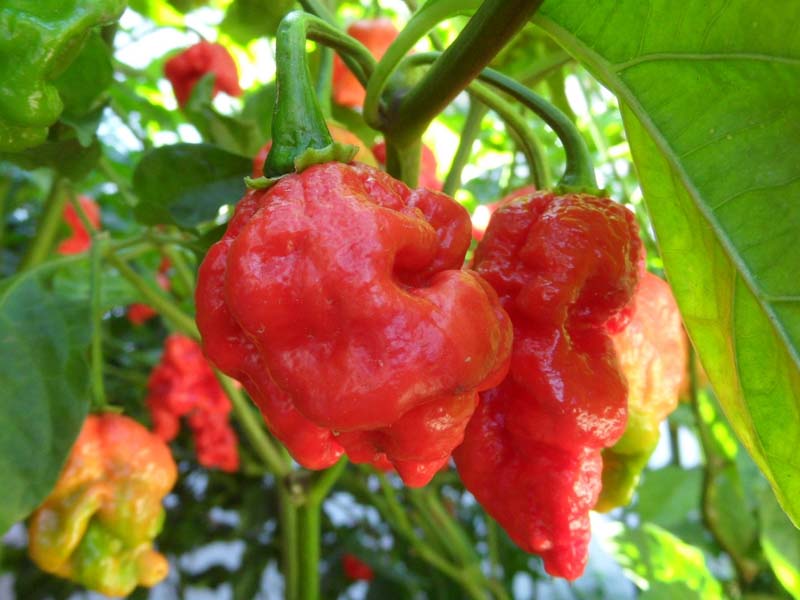 Species: capsicum chinense Grown by Troy Primeaux (nicknamed "Primo"), these are a cross between Naga Morich and 7 Pot chiles. Primeaux has since then grown them out for 6+ generations. 7 Pot Primos have are very distinctive with its long skinny "tail". They are among the top 5 hottest chile peppers on earth. Type: chile pepper | 1,469,000 Scoville Heat Units [SHU] 293.8 times hotter than a jalapeño |
Trinidad Scorpion (Butch T strain)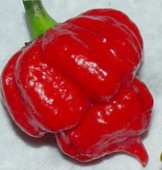 Species: capsicum chinense A superhot, bitter chile originating from the island of Trinidad. The Trinidad Scorpion was the world's hottest chile pepper in 2011 (it has since been dethroned by its sister strain, the Trinidad Moruga Scorpion) but is the current Guinness World Record holder until the folks at Guinness take a look at the recent NMSU CPI superhot research that was released in February 2012. The pods often look similar to a mushroom cloud or a jellyfish with slight habanero/scotch bonnet-like characteristics, and have a slightly bumpy appearance. Neil Smith of The Hippy Seed Company had a Trinidad Scorpion chile rated at 1,463,700 SHU, and named the origin strain after the one who provided the seeds, Butch Taylor of Zydeco Sauces. Type: chile pepper | 1,463,700 Scoville Heat Units [SHU] 292.74 times hotter than a jalapeño |
Naga Viper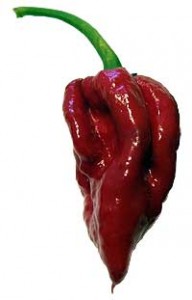 Species: capsicum chinense The Naga Viper pepper has a rating of 1,382,118 Scoville Heat Units (SHU). It is an unstable three-way hybrid produced from the Naga Morich, the Bhut Jolokia and the Trinidad Scorpion (some of the world's hottest peppers). Due to the nature of it being a hybrid it is unable to produce offspring exactly like the parent due to segregation of alleles and therefore traits. Type: chile pepper | 1,382,118 Scoville Heat Units [SHU] 276.42 times hotter than a jalapeño |
Trinidad 7 Pot Jonah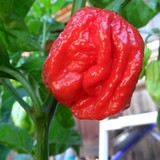 Species: capsicum chinense A superhot similar to the 7 Pot Douglah strain. Type: chile pepper | 800,000 - 1,200,000 Scoville Heat Units [SHU] 240 times hotter than a jalapeño |
Gibralta / Spanish Naga Chili Pepper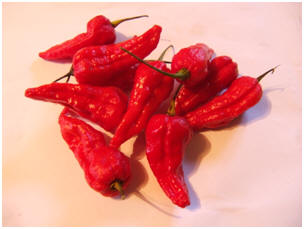 Species: capsicum chinense The Gibralta Naga, or Spanish Naga, is of course grown in Spain, but was developed in the UK from Indian chili peppers. It beat out the Bhut Jolokia for hottest pepper, but was soon overtaken. As they are grown, they are stressed by creating a hot environment, which helps to make the chiles extremely hot. They grow to about 3 inches and are round on top with a tapered end. They start out green and mature to red with wrinkled, knobby skin. Type: chile pepper | 1,086,844 Scoville Heat Units [SHU] 217.37 times hotter than a jalapeño |
Infinity Chilli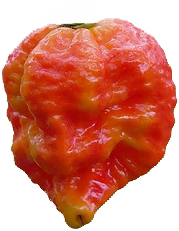 Species: capsicum chinense The Infinity Chile Pepper is a chili pepper created in England by chili breeder Nick Woods of Fire Foods, Grantham, Lincolnshire. For two weeks in February 2011, the Infinity Chilli held the Guinness World Record title for the world's hottest chilli with a Scoville scale rating of 1,067,286 Scoville Heat Units (SHU). Type: chile pepper | 1,067,286 Scoville Heat Units [SHU] 213.46 times hotter than a jalapeño |
Bhut Jolokia Pepper / Ghost Chile Pepper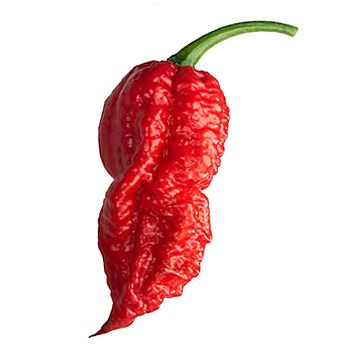 Species: capsicum chinense The Bhut/Naga/Bih Jolokia pepper is a chile pepper found naturally in the army garrison town of Tezpur, in the north-eastern state of Assam, India. It is a naturally occurring chile and held the Guinness World Record for the world's hottest pepper from 2007 until Januray 2011. The Bhut Jolokia is also know as The "Ghost Chili/Chile", Nagahari, Naga Jolokia, Bih Jolokia, Borbih, Raja Mircha, Raja Chilli, Mirch, Mircha, Naga Moresh, Naga Morich, Tezpur, Bih Jolokia and Bhwt Jolokiya (with possible slight variations). Type: chile pepper | 855,000 - 1,041,427 Scoville Heat Units [SHU] 208.29 times hotter than a jalapeño |
Dorset Naga Pepper Species: capsicum chinense The Dorset Naga pepper (Capsicum chinense) is a variety of chile pepper grown in West Bexington, Dorset, England. Type: chile pepper | 876,000 - 970,000 Scoville Heat Units [SHU] 194 times hotter than a jalapeño |
Trinidad 7 Pot CARDI Strain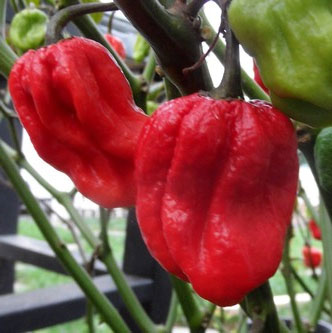 Species: capsicum chinense A superhot similar to the 7 Pot Douglah strain. Type: chile pepper | 850,000 Scoville Heat Units [SHU] 170 times hotter than a jalapeño |
Trinidad Yellow Scorpion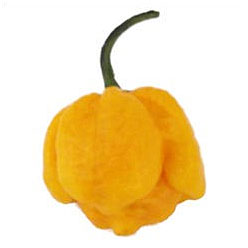 Species: capsicum chinense A slightly less-hot version of the red Trinidad Scorpion Pepper. Type: chile pepper | 400,000 - 600,000 Scoville Heat Units [SHU] 120 times hotter than a jalapeño |
Red Savina Habanero Pepper Species: capsicum chinense The Red Savina pepper is a cultivar of the habanero chile (Capsicum chinense Jacquin), which has been selectively bred to produce hotter, heavier, and larger peppers. They have been measured to reach as high as nearly 580,000 Scoville units. Type: chile pepper | 350,000 - 577,000 Scoville Heat Units [SHU] 115.4 times hotter than a jalapeño |
Devil's Tongue - Chocolate Species: capsicum chinense A brown-colored version of the hot devil's tongue pepper Type: chile pepper | 500,000 Scoville Heat Units [SHU] 100 times hotter than a jalapeño |
Devil's Tongue - Red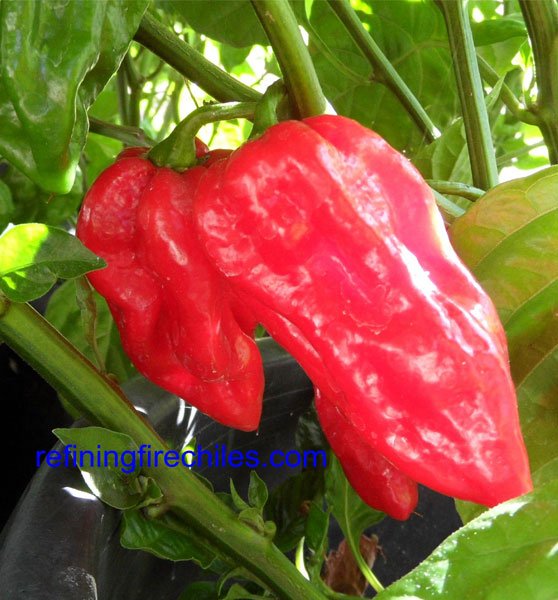 Species: capsicum chinense A red-colored version of the hot devil's tongue pepper Type: chile pepper | 400,000 - 500,000 Scoville Heat Units [SHU] 100 times hotter than a jalapeño |
Congo Pepper - Black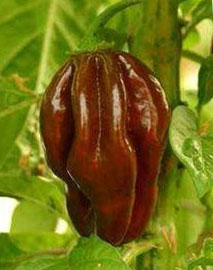 Species: capsicum chinense A black-colored version of the hot Congo chile Type: chile pepper | 300,000 - 500,000 Scoville Heat Units [SHU] 100 times hotter than a jalapeño |
Jamaican Hot Pepper - Chocolate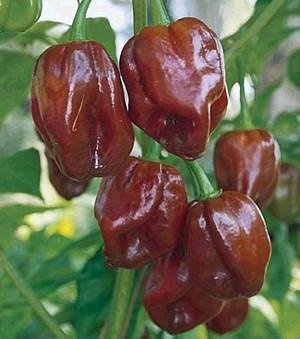 Species: capsicum chinense A hot pepper variety originating from Jamaica, in a spicier brown color Type: chile pepper | 300,000 - 500,000 Scoville Heat Units [SHU] 100 times hotter than a jalapeño |
Habanero Chile Pepper - Chocolate Species: capsicum chinense This is a brown-colored version of the popular habanero pepper. Type: chile pepper | 300,000 - 500,000 Scoville Heat Units [SHU] 100 times hotter than a jalapeño |
Trinidad Yellow 7 Pot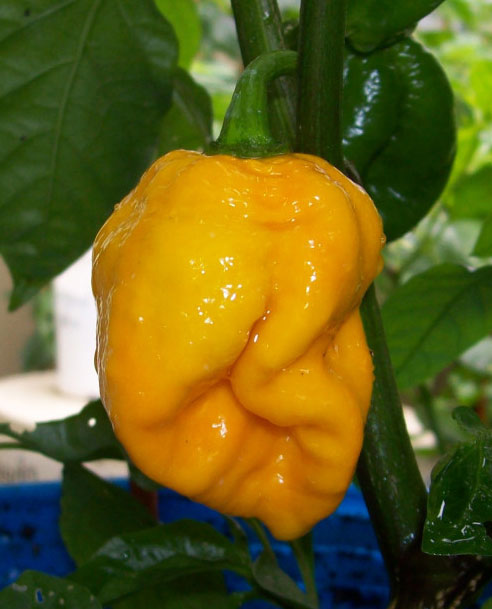 Species: capsicum chinense A slightly less hot version of the Trinidad 7 Pot Type: chile pepper | 500,000 - 600,000 Scoville Heat Units [SHU] 100 times hotter than a jalapeño |
Devil's Tongue - Yellow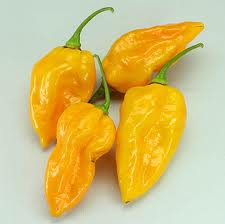 Species: capsicum chinense A yellow-colored version of the hot devil's tongue pepper. Type: chile pepper | 400,000 Scoville Heat Units [SHU] 80 times hotter than a jalapeño |
Congo Pepper - Red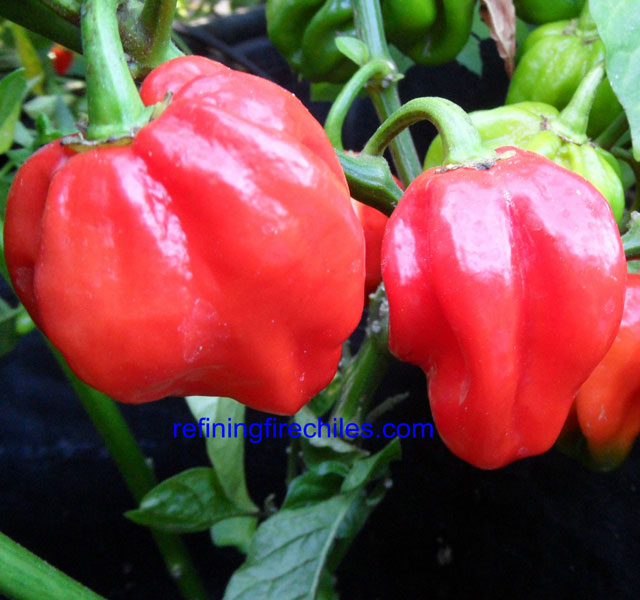 Species: capsicum chinense A red-colored version of the hot Congo chile Type: chile pepper | 300,000 - 400,000 Scoville Heat Units [SHU] 80 times hotter than a jalapeño |
Habanero Chile Pepper - Orange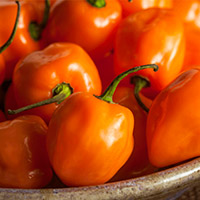 Species: capsicum chinense The habanero chile (Capsicum chinense Jacquin) (Spanish, from Havana) is the most intensely spicy chile pepper of the Capsicum genus. It is a popular ingredient in super-hot sauces and dishes. This orange-colored version is perhaps the most widespread variation of habaneros. Type: chile pepper | 100,000 - 350,000 Scoville Heat Units [SHU] 70 times hotter than a jalapeño |
Scotch Bonnet Pepper Species: capsicum chinense The Scotch Bonnet is a variety of chile pepper similar to and of the same species as the habanero. A cultivar of the habanero, it is reputed by some as one of the hottest peppers in the world. It is found mainly in the Caribbean islands and is named for its resemblance to a Scot's bonnet. Most Scotch Bonnets have a heat rating between 150,000 and 325,000 Scoville Units. Type: chile pepper | 100,000 - 325,000 Scoville Heat Units [SHU] 65 times hotter than a jalapeño |
Congo Pepper - Yellow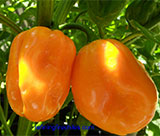 Species: capsicum chinense A yellowcolored version of the hot Congo chile Type: chile pepper | 300,000 Scoville Heat Units [SHU] 60 times hotter than a jalapeño |
Birds Eye Pepper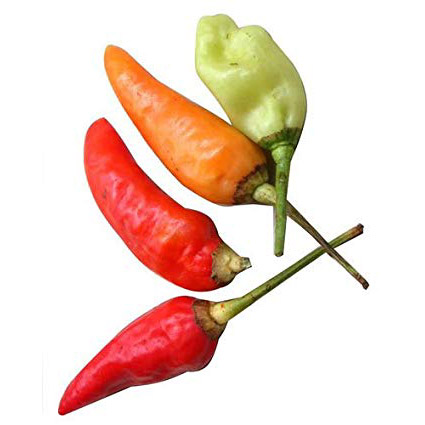 Species: capsicum annuum Bird's eye chili, bird's chili or Thai chili, is a chili pepper, a cultivar from the species Capsicum annuum, commonly found in Southeast Asia. It is often confused with a similar-looking chili derived from the species Capsicum frutescens, the cultivar 'siling labuyo'. Bird's eye chili can also be found in India, in Meghalaya and Kerala. Type: chile pepper | 100,000 - 225,000 Scoville Heat Units [SHU] 45 times hotter than a jalapeño |
Madame Jeanette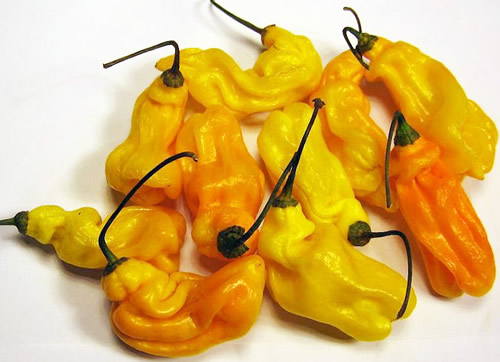 Species: capsicum chinense These peppers are used amongst others in Surinam and the Netherlands to make a great, bright yellow sambal. Type: chile pepper | 225,000 Scoville Heat Units [SHU] 45 times hotter than a jalapeño |
Jamaican Hot Pepper - Red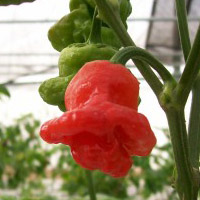 Species: capsicum chinense A hot pepper variety originating from Jamaica. Type: chile pepper | 200,000 Scoville Heat Units [SHU] 40 times hotter than a jalapeño |
Carolina Cayenne Pepper Species: capsicum annuum The Carolina Cayenne Pepper is a native of Central and South America. Today, it is cultivated around the world and offered as a spice. A mature Carolina Cayenne will be over five inches in length and about an inch in width. This pepper first appears in green on the plant. With maturation, it turns to a blood red color. They have very wrinkled and thin skin with the shape of an elongated teardrop. Carolina Cayenne's are nearly two times as hot as the typical cayenne pepper. The Scoville heat scale shows a rating for them of 100,000-125,000 SHU or Scoville Heat Units. Type: chile pepper | 100,000 - 125,000 Scoville Heat Units [SHU] 25 times hotter than a jalapeño |
Fatalli Pepper Species: capsicum chinense The Fatalii (Capsicum chinense) is a chili that originates in central and southern Africa. It is described to have a fruity, citrus flavor with a searing heat that is comparably hotter to the standard habanero. The Scoville units of a Fatalii range about 125,000 ~ 400,000 units. Type: chile pepper | 125,000 - 400,000 Scoville Heat Units [SHU] 25 times hotter than a jalapeño |
Tabiche Pepper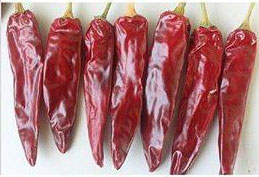 Species: capsicum annuum Originally from India, the Tabiche pepper can now be found growing worldwide and often year-round, but it does best in hot, dry climates. It grows to about three inches in length and an inch in width, with the shape of a thin teardrop. It has wrinkled, thin skin, and can mature to a pale yellow or a bright, glossy red. Type: chile pepper | 85,000 - 115,000 Scoville Heat Units [SHU] 23 times hotter than a jalapeño |
Bahamian Pepper Species: capsicum annuum As its name suggests, the Bahamian pepper originates from the Bahamas, where it is still one of the major agricultural crops. This small, round pepper grows to only about an inch in length, and may be found in an assortment of colors, including yellow, orange, green and red. Interestingly, the Bahamian pepper grows upright in clusters, unlike most peppers that hang from their stems. At roughly 100,000 Scovilles, they are hotter than the cayenne, but not quite as hot as most habaneros. They make a deliciously spicy addition to many foods and dishes. Type: chile pepper | 95,000 - 110,000 Scoville Heat Units [SHU] 22 times hotter than a jalapeño |
Thai Pepper Species: capsicum annuum There are three varities of thai peppers, the hottest of which can reach as high as 100,000 on the Scoville scale. Type: chile pepper | 50,000 - 100,000 Scoville Heat Units [SHU] 20 times hotter than a jalapeño |
Chiltepin pepper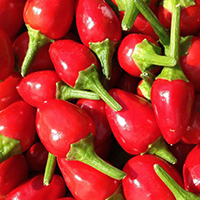 Species: capsicum annuum Chiltepin is a wild chile pepper that grows in Mexico and the southwestern United States. It is sometimes called the "mother of all peppers," because it is thought to be the oldest species in the Capsicum genus. The chiles are extremely hot, rating 50,000 to 100,000 Scoville units, but the heat quickly dissipates. Type: chile pepper | 50,000 - 100,000 Scoville Heat Units [SHU] 20 times hotter than a jalapeño |
Datil Pepper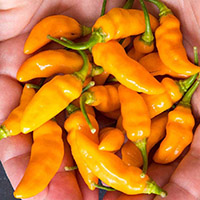 Species: capsicum chinense A very hot chili; primarily grown in Florida. Type: chile pepper | 100,000 to 300,000 Scoville Heat Units [SHU] 20 times hotter than a jalapeño |
Jamaican Hot Pepper - Yellow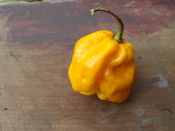 Species: capsicum chinense A hot pepper variety originating from Jamaica, in a milder yellow color Type: chile pepper | 100,000 Scoville Heat Units [SHU] 20 times hotter than a jalapeño |
Pico de Pajaro Pepper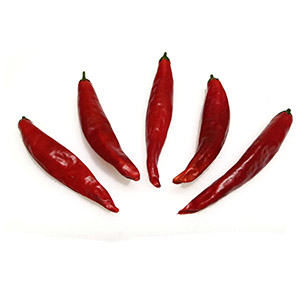 Species: capsicum annuum Translates to "Bird's beak" and originates from Yecora, Sonora, Mexico. The knobby fruit are often curved. Pods are almost 1" wide and 5-51/2" long. Also known as 'Cola de Rata' (Rat tail). Type: chile pepper | 70,000 - 100,000 Scoville Heat Units [SHU] 14 times hotter than a jalapeño |
Charleston Hot Pepper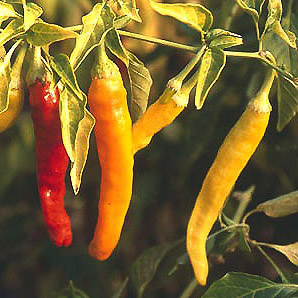 Species: capsicum annuum Similar to the Carolina Cayenne, the Charleston Hot is a variety of Cayenne created by the U.S. Department of Agriculture in South Carolina. Although it was not bred for its heat, it is much hotter than a regular cayenne, which averages about 30,000 Scovilles. In fact, it's almost as hot as a habanero but with a great cayenne flavor. The Charleston Hot starts out green and turns to yellow, then orange, then bright red. It can be harvested during its immature stages, but most people are familiar with its typical mature, red color. The peppers are long and skinny, growing to about 5 inches in length, and 3/4 inch in width. Type: chile pepper | 70,000 - 100,000 Scoville Heat Units [SHU] 14 times hotter than a jalapeño |
Malagueta Pepper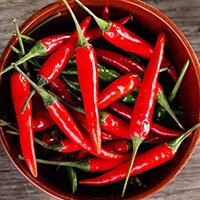 Species: capsicum frutescens Malagueta pepper is a type of chile used in Brazil, Portugal and Mozambique. It is heavily used in the Bahia area of Brazil . It apparently gets its name from the unrelated melegueta pepper from West Africa (Zingiberaceae). It is a small, tapered, green pepper that turns red as it matures. It is about 2 inches in length at maturity. It is a very hot pepper, with a range of 60,000 to 100,000 Scoville units (about the same as Tabasco peppers). There are two sizes seen in markets, which will sometimes have different names: the smaller ones are called "malaguetinha" in Brazil and "piri-piri" in Portugal and Mozambique, and the larger ones are called "malaguetao" in Brazil and "malagueta" in Portugal. They are not different varieties, just peppers of different maturities from the same plant. Type: chile pepper | 60,000 Scoville Heat Units [SHU] 12 times hotter than a jalapeño |
China Express Pepper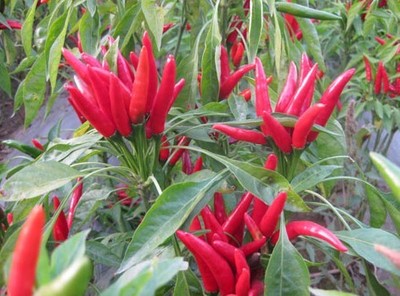 Species: capsicum annuum Biting, red, and scorching hot peppers. Type: chile pepper | 60,000 - 100,000 Scoville Heat Units [SHU] 12 times hotter than a jalapeño |
Diablo Grande Pepper Species: capsicum annuum A banana-type chile pepper that packs plenty of heat, the Diablo Grande is several times hotter than jalapeno and serrano peppers. It is one of numerous members of the Longum group, which encompasses poblanos, serranos, jalapenos, cayenne peppers and various other chile peppers. These annual vegetables descend from varieties that were grown and selected by Native Americans for thousands of years. Type: chile pepper | 60,000 - 100,000 Scoville Heat Units [SHU] 12 times hotter than a jalapeño |
Pequin Pepper Species: capsicum annuum Sometimes spelled "piquin", the Pequin pepper (pronunciation: pee/puh-KEEN) is a hot chile pepper cultivar commonly used as a spice. Pequin has a compact habit growing typically 0.3-0.6 meters tall, with bright green, ovate leaves and small fruits that rarely exceed 2 cm in length. Like most chiles, fruits start out green, ripening to brilliant red at maturity. Pequin peppers are very hot, often 13-40 times hotter than jalapenos on the Scoville scale (100,000-140,000 units). Flavor is described as citrusy, smoky (if dried with wood smoke), and nutty Common uses include pickling, salsas and sauces, soups, and vinegars. The popular Cholula brand hot sauce lists pequin peppers and arbol peppers among its ingredients. Type: chile pepper | 40,000 - 58,000 Scoville Heat Units [SHU] 11.6 times hotter than a jalapeño |
Super Chile Pepper Species: capsicum annuum These small peppers grow upright in clusters and mature from light green to red, often with shades of orange in between. They do best in a hot, humid climate. They grow to 1 1/2"-2" in length and 1/2"- 1" in width and have a cone shape. They are decorative and colorful, and are often used as a border in gardens with limited space. Type: chile pepper | 40,000 - 50,000 Scoville Heat Units [SHU] 10 times hotter than a jalapeño |
Cayenne Pepper Species: capsicum annuum Cayenne pepper is a popular, hot red pepper used to flavor spicy dishes and sauces. Type: chile pepper | 30,000 - 50,000 Scoville Heat Units [SHU] 10 times hotter than a jalapeño |
Aji Pepper Species: capsicum baccatum The Aji pepper, also known as Peruvian hot pepper, is a unique species of chili pepper, Capsicum baccatum, containing several different breeds. Type: chile pepper | 30,000 - 50,000 Scoville Heat Units [SHU] 10 times hotter than a jalapeño |
Santaka Pepper Species: capsicum annuum The Santaka Pepper is a hot chili pepper that originates from Japan. It is rather small in size, measuring about two inches in length and up to an inch in width, at maturity. It has a tapered teardrop shape and a vibrant red color. At harvest time, the skin of the fruit is thin and wrinkled. The flavor of the Santaka pepper is one of intense spiciness. Type: chile pepper | 30,000 - 50,000 Scoville Heat Units [SHU] 10 times hotter than a jalapeño |
Tabasco Pepper Species: capsicum frutescens The tabasco pepper a variety of the chile pepper species Capsicum frutescens. It is best known through its use in Tabasco sauce. A medium hot to very hot pepper. Type: chile pepper | 30,000 - 50,000 Scoville Heat Units [SHU] 10 times hotter than a jalapeño |
Tien Tsin Pepper Species: capsicum annuum Sometimes referred to as the Tianjin pepper, the Tien Tsin Pepper is a chile pepper variety grown and used in China. Type: chile pepper | 50,000-75,000 Scoville Heat Units [SHU] 10 times hotter than a jalapeño |
Manzano Pepper Species: capsicum pubescens Manzano chile peppers are relatives of the hot South American rocoto peppers. They are used most often in fresh form because the pods are so thick they are difficult to dry. These peppers are great for making hot salsas. It is unusual in that it has black seeds. Type: chile pepper | 12,000 - 30,000 Scoville Heat Units [SHU] 6 times hotter than a jalapeño |
De Arbol pepper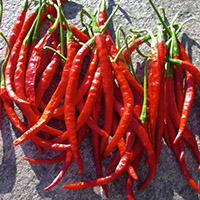 Species: capsicum anuum A Chile De Arbol slender, commonly-used pepper with a medium hot taste. Type: chile pepper | 15,000 - 30,000 Scoville Heat Units [SHU] 6 times hotter than a jalapeño |
Serrano Pepper Species: capsicum annuum A serrano pepper is a type of chile pepper that originated in the mountainous regions of the Mexican states of Puebla and Hidalgo. Type: chile pepper | 10,000 - 23,000 Scoville Heat Units [SHU] 4.6 times hotter than a jalapeño |
Chungyang Red Pepper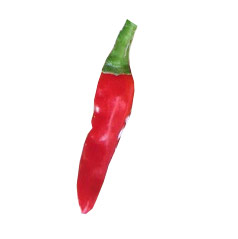 Species: capsicum annuum The Chungyang Red Pepper' is a small-sized chili pepper that has a strong burning sensation when eaten. It is a cultivar of the species Capsicum annuum originating in South Korea and developed by Dr. Il-ung Yoo by hybridizing Thai and Jeju-do cultivars. Chungyang Red Peppers have 10,000 - 23,000 Scoville heat units. Type: chile pepper | 10,000 - 23,000 Scoville Heat Units [SHU] 4.6 times hotter than a jalapeño |
Aleppo Pepper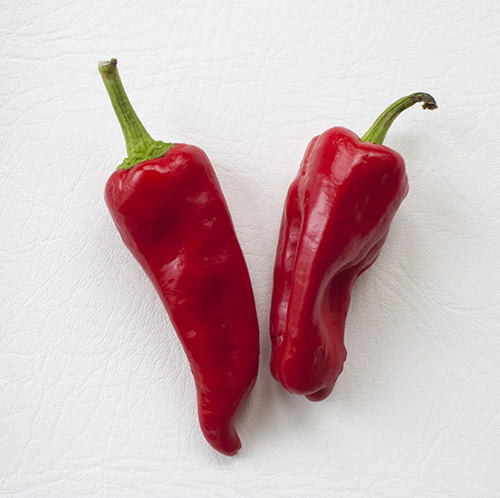 Species: capsicum annuum The Aleppo pepper, also known as the Halaby pepper, is named after the city of Aleppo in Northern Syria. It is commonly grown in Syria and Turkey, and is usually dried and crushed. Aleppo pepper is used in Mediterranean and Middle Eastern cuisine, although it has become very popular around the world as an alternative to crushed red pepper or paprika, due to its beautiful deep red color, rich fruity undertones and aromatic flavor. It is perfect for chili, pizza, sauces, or anywhere you may normally use paprika, if you like the extra heat. However, it is not as hot as conventional crushed red pepper, because it is de-seeded before it is crushed. Type: chile pepper | 10,000 Scoville Heat Units [SHU] 2.1 times hotter than a jalapeño |
Hungarian Wax Pepper Species: capsicum annuum The Hungarian wax pepper is a pastel yellow chile pepper also known as the hot yellow pepper or hot wax pepper. The Hungarian wax is closely related to the mild banana pepper. These peppers appear so much alike they cannot usually be distinguished except by taste. They are often used in Hungarian stews and go well with bean dishes. Type: chile pepper | 5,000 - 10,000 Scoville Heat Units [SHU] 2 times hotter than a jalapeño |
Chipotle Pepper Species: capsicum annuum There is no naturally-occurring chipotle in nature; it is simply a jalapeno pepper that has been smoked. It has a slightly higher Scoville count than a regular Jalapeno. Spicy, smoky, sweet, and flavorful. Type: chile pepper | 5,000 - 10,000 Scoville Heat Units [SHU] 2 times hotter than a jalapeño |
Jalapeño Pepper Species: capsicum annuum Perhaps the most popular and most widely-used hot pepper in the western world. The jalapeño is a small to medium-sized chile pepper that is prized for the hot, burning sensation that it produces in the mouth when eaten. Jalapeño have a wide variety of culinary uses: snacks, dishes, sauces and salsas are just a few. The jalapeño is known by different names throughout Mexico: cuaresmenos, huachinangos and chiles gordos. A smoked jalapeño is known as a chipotle pepper. Type: chile pepper | 2,500 - 8,000 Scoville Heat Units [SHU] |
Guajillo Pepper Species: capsicum annuum Sometimes (incorrectly) spelled "guajilla". They are thick, leathery dark reddish brown (when mature) chiles that contain mild to moderate amounts of heat. The guajillo is one of the most commonly grown chiles in Mexico. This chile requires a longer soaking period than most due to its leathery skin. Type: chile pepper | 2,500 - 5,000 Scoville Heat Units [SHU] Approx. equal in heat to a jalapeño |
Sandia Pepper Species: capsicum annuum A spicy, southern "NuMex" pepper. Type: chile pepper | 1,500 - 2,500 Scoville Heat Units [SHU] Only 50% the heat of a jalapeño |
Rocotillo Pepper Species: capsicum baccatum Rocotillos are clustered, bell-blossom-shaped peppers with a pleasant flavor, often served fresh to accompany roasted meats or cooked beans. Type: chile pepper | 1,500 - 2,500 Scoville Heat Units [SHU] Only 50% the heat of a jalapeño |
Cascabel Pepper Species: capsicum annuum The cascabel is a small, round, hot chilli pepper. It is a cultivar of the species Capsicum annuum. Its name is a Spanish word for "small bell" or "rattle". The pepper, when dried makes a rattling noise and as such can be used to make music. Type: chile pepper | 1,000 - 2,500 Scoville Heat Units [SHU] Only 50% the heat of a jalapeño |
Cherry Pepper Species: capsicum annuum Also called Hungarian cherry peppers, these are mild and sweet. Very similar to the cascabel pepper. Small in size and round in shape, this variety of pepper has the appearance of a large cherry or a small cherry tomato. Type: chile pepper | 1,000 - 2,500 Scoville Heat Units [SHU] Only 50% the heat of a jalapeño |
Fresno Pepper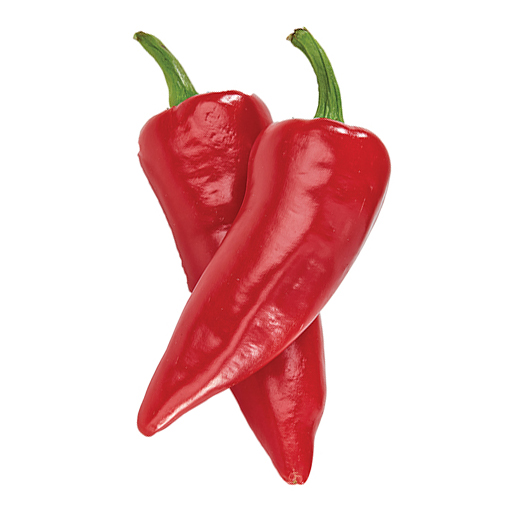 Species: capsicum annuum Same species as the Jalapeno but is more ripe and has a higher vitamin content. Frequently used in ceviche and is one of the most frequently used chilies in salsa. Type: chile pepper | 2500-10000 Scoville Heat Units [SHU] Only 50% the heat of a jalapeño |
Anaheim Pepper Species: capsicum annuum This mild pepper is also known as California, long green chili, chilacate, chile college, chile de rista, chile verde, Chimayo and Hatch. Type: chile pepper | 500 - 2,500 Scoville Heat Units [SHU] Only 50% the heat of a jalapeño |
Ancho Pepper Species: capsicum annuum Ancho peppers are are the dried version of Poblano, or "people" peppers. Their flavor is somewhat sweet and somewhat raisin-like, with medium heat. The outer skin has a rich, sweet, raisin-like flavor, which is most commonly associated with the flavor of chili; the inner veins of the pepper are quite hot. When you buy the whole pod, you have the advantage of being able to separate these two distinct flavors. Type: chile pepper | 1,000 - 2,000 Scoville Heat Units [SHU] Only 40% the heat of a jalapeño |
Pasilla Pepper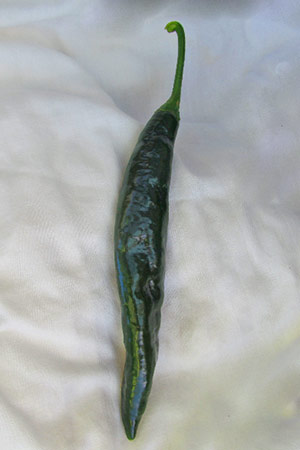 Species: capsicum annuum The true pasilla pepper is a long, thin pepper 7 to 12 inches long by 1 inch in diameter. Pasillas turn from dark green to dark brown/purple as they mature. Slightly spicy in taste. Called Chilaca in its fresh form. Type: chile pepper | 1,000 - 2,000 Scoville Heat Units [SHU] Only 40% the heat of a jalapeño |
Poblano Pepper Species: capsicum annuum The Poblano is a mild chile pepper, just slightly spicier than a bell pepper. Type: chile pepper | 1,000 - 1,500 Scoville Heat Units [SHU] Only 30% the heat of a jalapeño |
Espanola Pepper Species: capsicum annuum A locally named hot cultivar from New Mexico. Type: chile pepper | 1,000 - 1,500 Scoville Heat Units [SHU] Only 30% the heat of a jalapeño |
Mirasol Pepper Species: capsicum annuum A dried form the of guajillo chile pepper. The Mirasol is thin-skinned pepper can vary more than any other chile in looks, and therefore may be hard to recognize. Sometimes small, sometimes large, smooth or wrinkled, it is quite inconsistent. Known for its distinct berry like, fruity flavor that enhances potatoes chicken, and pork. Spices up hot salsas, stews, and mole sauces. Type: chile pepper | 1,500 - 2,500 Scoville Heat Units [SHU] Only 30% the heat of a jalapeño |
Peppadew Pepper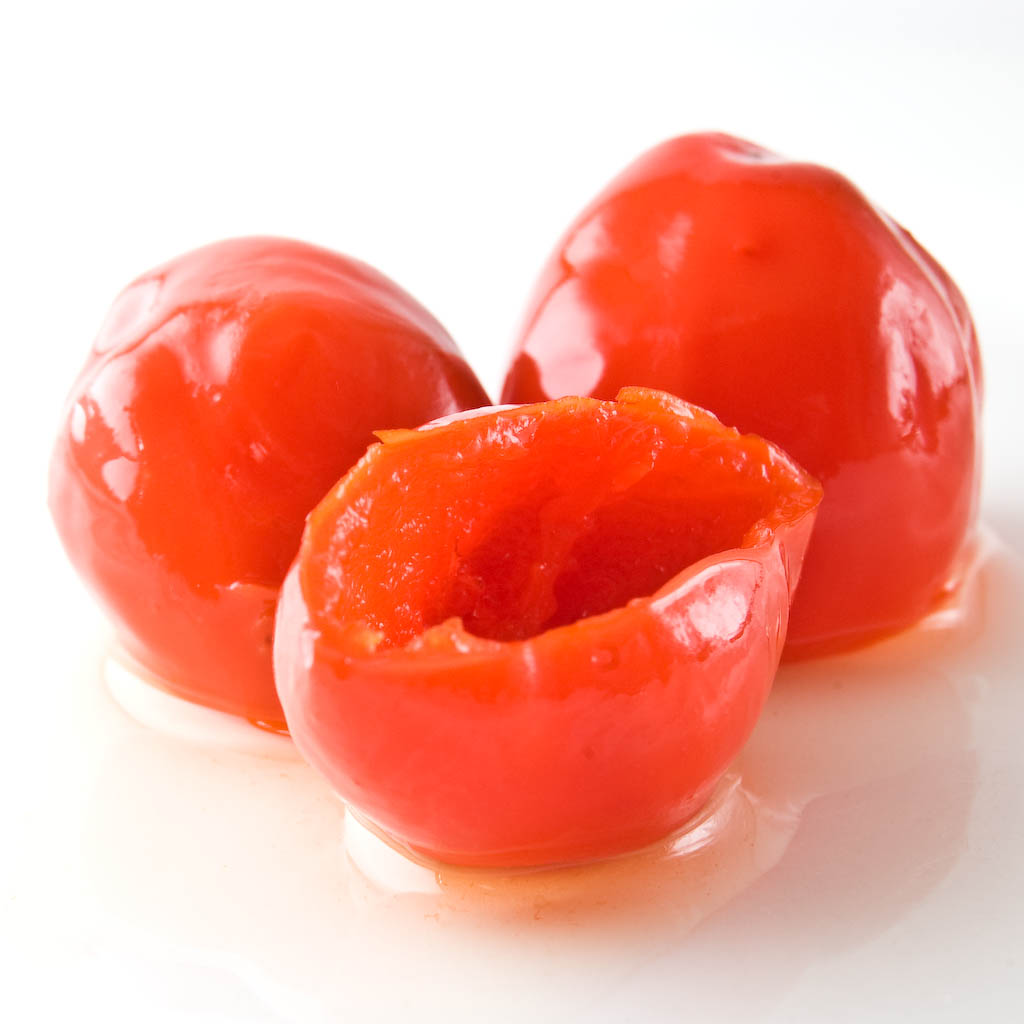 Species: capsicum baccatum Technically called the sweet piquant� pepper. These resemble cherry tomatoes. Contains a mild heat. Type: chile pepper | 1,177 Scoville Heat Units [SHU] Only 24% the heat of a jalapeño |
Coronado Pepper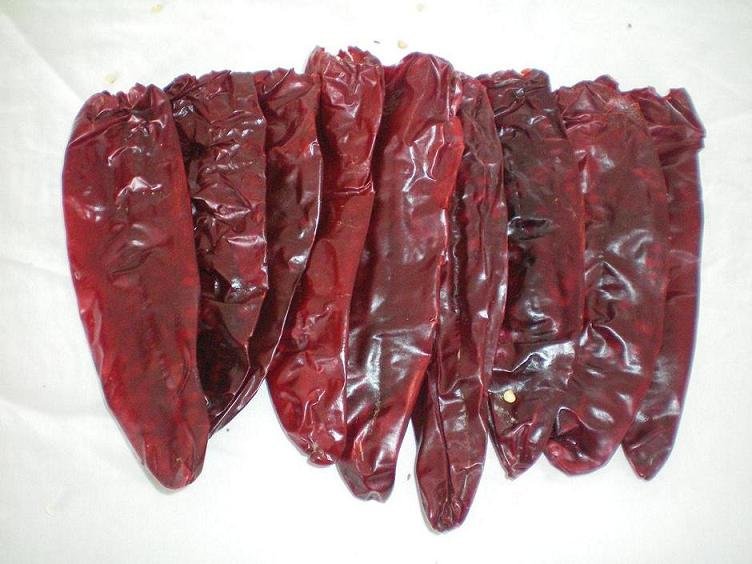 Species: capsicum annuum Originally from South America, the Coronado Pepper grows to 4" long and 2" wide with thin, waxy skin. It tastes like a mix of pear and berries, and turns a bright red when ripe. With its mild flavor, it can be eaten fresh, added to dishes for extra flavor, or dried and ground into powder. Type: chile pepper | 700 - 1000 Scoville Heat Units [SHU] Only 20% the heat of a jalapeño |
New Mexico Chile Pepper Species: capsicum annuum New Mexican chiles are mild, large chiles with a unique flavor. These peppers are the only pepper that is suitable for preparing New Mexican style red sauces, such as enchilada sauce, some salsas or chile marinades. Type: chile pepper | 500 - 1000 Scoville Heat Units [SHU] Only 20% the heat of a jalapeño |
Paprika Pepper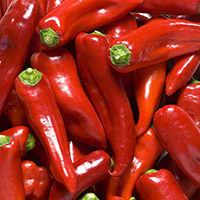 Species: capsicum annuum The paprika pepper is a hefty, cone-shaped chile pepper. The pepper was brought over to Europe from the Americas centuries ago and have been cultivated primarily in the country of Hungary. The paprika is a fairly large red pepper and quite long, growing up to 8 inches. Although it can and often is a primary ingredient in paprika spice, other sweet and mild chile peppers can be used and blended in as well. Paprika spice is used to give dishes a bright red color, along with a notes of sweetness and earthiness. Type: chile pepper | 250-1,000 Scoville Heat Units [SHU] Only 20% the heat of a jalapeño |
Santa Fe Grande Pepper Species: capsicum annuum Santa Fe Grande (Capsicum annuum) The Santa Fe Grande is a very prolific variety used in the southwest. The conical, blunt fruits ripen from greenish-yellow, to orange-yellow to red. The peppers grow upright on 24" plants. Santa Fe Grande's have a slightly sweet taste and are fairly mild in pungency. Type: chile pepper | 500 - 700 Scoville Heat Units [SHU] Only 14% the heat of a jalapeño |
Pimento Pepper Species: capsicum annuum The Pimento or Cherry Pepper is a variety of large, red, heart-shaped chile pepper (Capsicum annuum). They are very mild and sweet in taste. Type: chile pepper | 100 - 500 Scoville Heat Units [SHU] Only 10% the heat of a jalapeño |
Pepperoncini Pepper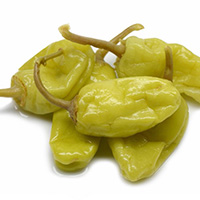 Species: capsicum annuum The pepperoncini (Friggitello, Italian peperone, peperoncino), also known as Tuscan peppers, sweet Italian peppers, banana peppers, waxed peppers, and golden Greek peppers, is a variety of Capsicum annuum. These peppers are mild and sweet with a slight heat to them, and are commonly jarred and pickled for use in Greek salads and salad bars. Type: chile pepper | 100 - 500 Scoville Heat Units [SHU] Only 10% the heat of a jalapeño |
Mexi-Bell Pepper Species: capsicum annuum Sometimes spelled Mexibelle, this is a cross between Sweet Bell peppers and hotter chile peppers. These look like small, red Bell peppers and a because of their often smoother features, they can also appear to be a tomato from a distance. Type: chile pepper | 100 -1,000 Scoville Heat Units [SHU] Only 2% the heat of a jalapeño |
NuMex Big Jim Pepper Species: capsicum annuum Very large (possible the biggest in the world) of the New Mexican variety. Very mild and sweet. Type: chile pepper | 100 - 1,000 Scoville Heat Units [SHU] Only 2% the heat of a jalapeño |
Cubanelle Pepper Species: capsicum annuum The Cubanelle is a variety of sweet pepper. When unripe, it is light yellowish-green in color, but eventually turns bright red. Compared to bell peppers it has thinner flesh, is longer, and has a slightly more wrinkled appearance. It is used extensively in Puerto Rico's cuisine. Cubanelle peppers are used in the U.S. to replace Poblano peppers. Most of the cubanelle pepper imports come from the Dominican Republic (where it's called aji cubanela), which has been of late the main exporter of this cultivar. Type: chile pepper | 100 - 1,000 Scoville Heat Units [SHU] Only 2% the heat of a jalapeño |
Sweet Bell Pepper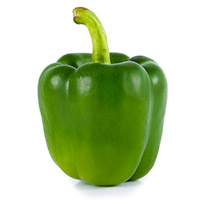 Species: capsicum annuum Very little to no heat, the common bell pepper comes in a variety of colors, most often green, red, yellow, and orange. Type: chile pepper | 0 - 100 Scoville Heat Units [SHU] Only 1% the heat of a jalapeño |
Please keep in mind that the Scoville heat units listed are just estimates at best. Scoville units for each sauce or chile pepper may vary greatly due to the seed lineage, season, climate, soil, and other conditions in which the peppers and ingredients are grown.
Comparisons in this Scoville Scale chart to jalapeño peppers are based on an "average" of 5,000 SHU for the jalapeño, and the high end SHU for the sauce or pepper in question.
Big thanks and credits go to Chez Williams, ChilliWorld and SweatNSpice.com for help with the original numbers, and Jim Duffy's Refining Fire Chiles and Michael Hultquist's Chili Pepper Madness for many of the photos of the chile peppers. You guys rock!
If you find anything missing from this Scoville Scale chart, please contact me. Thanks!

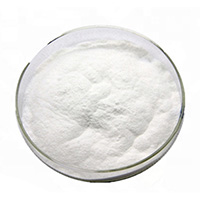


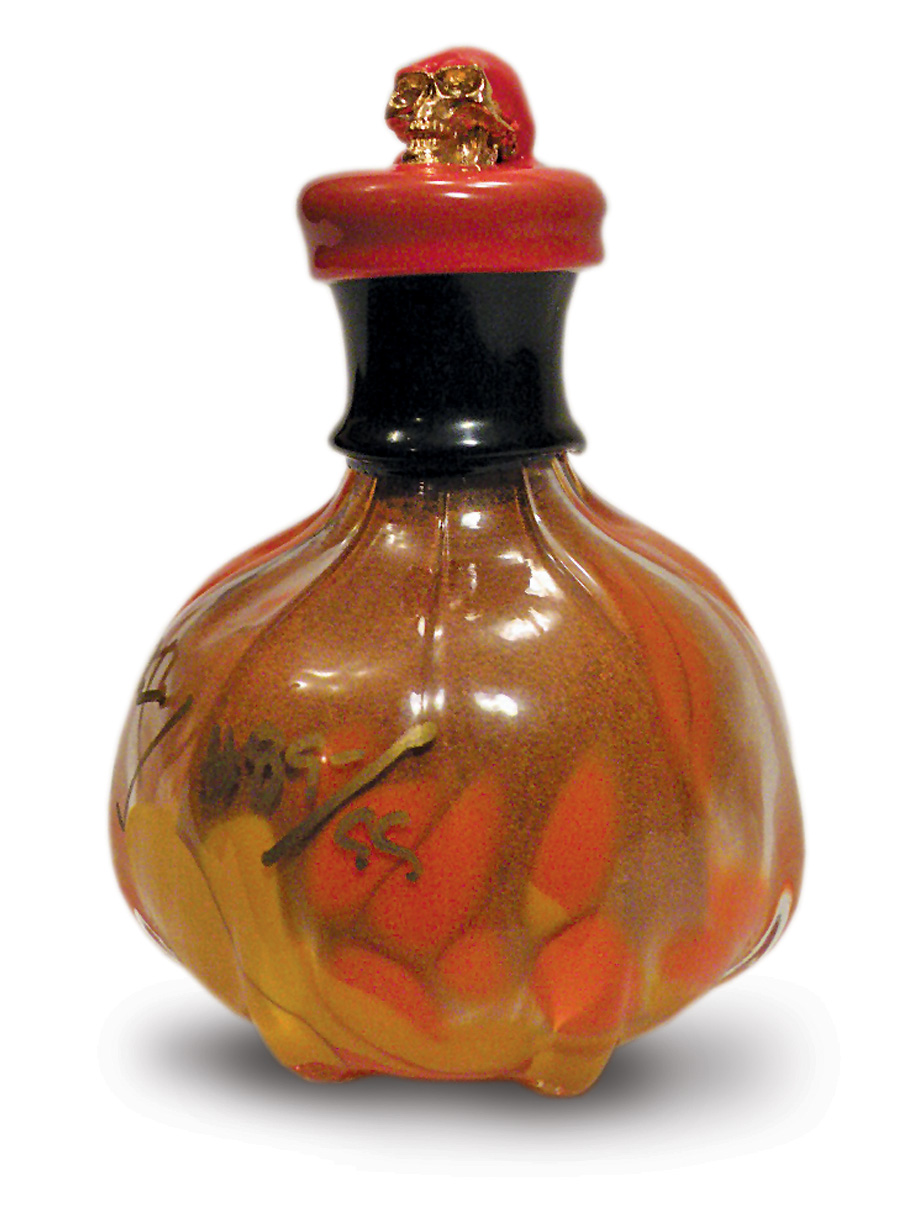
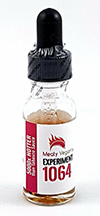







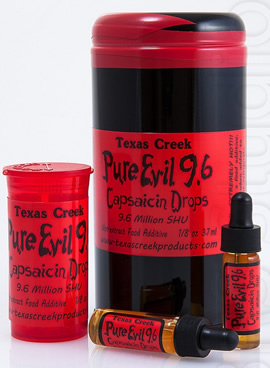


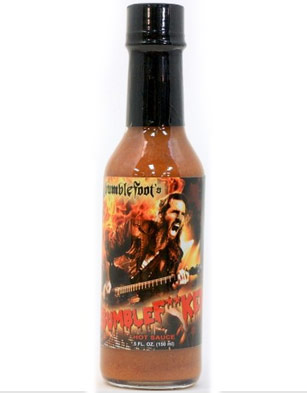
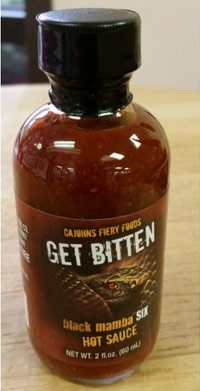


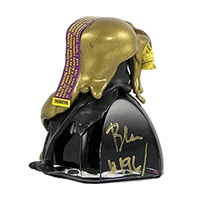

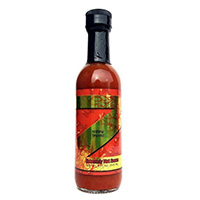


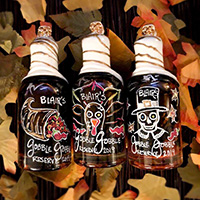
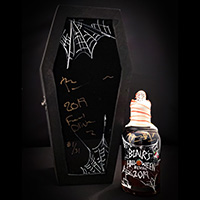

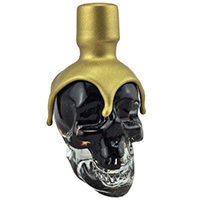



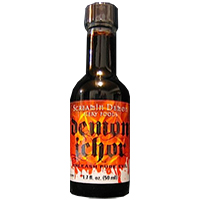
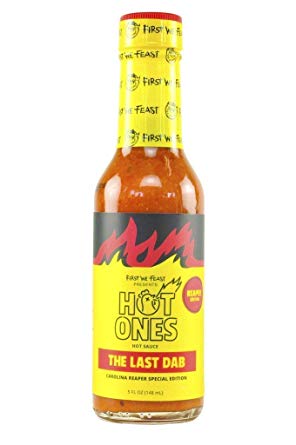
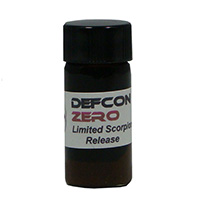
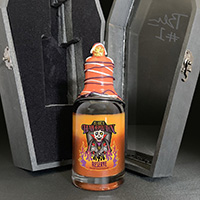
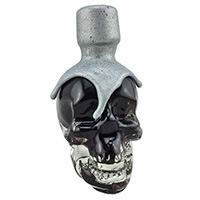
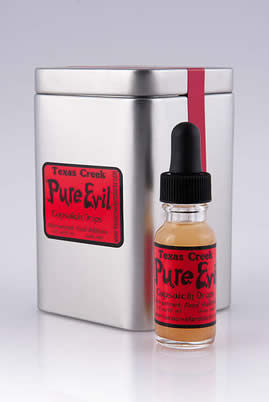
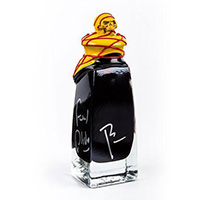
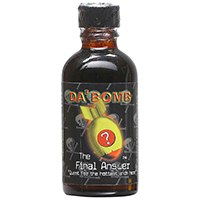



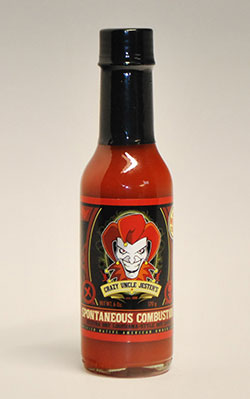
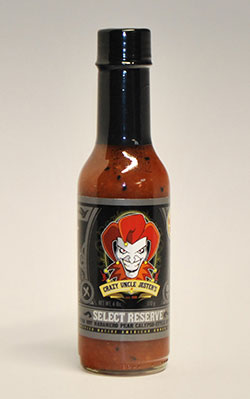








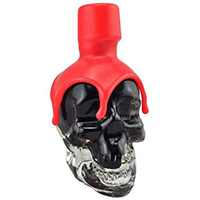







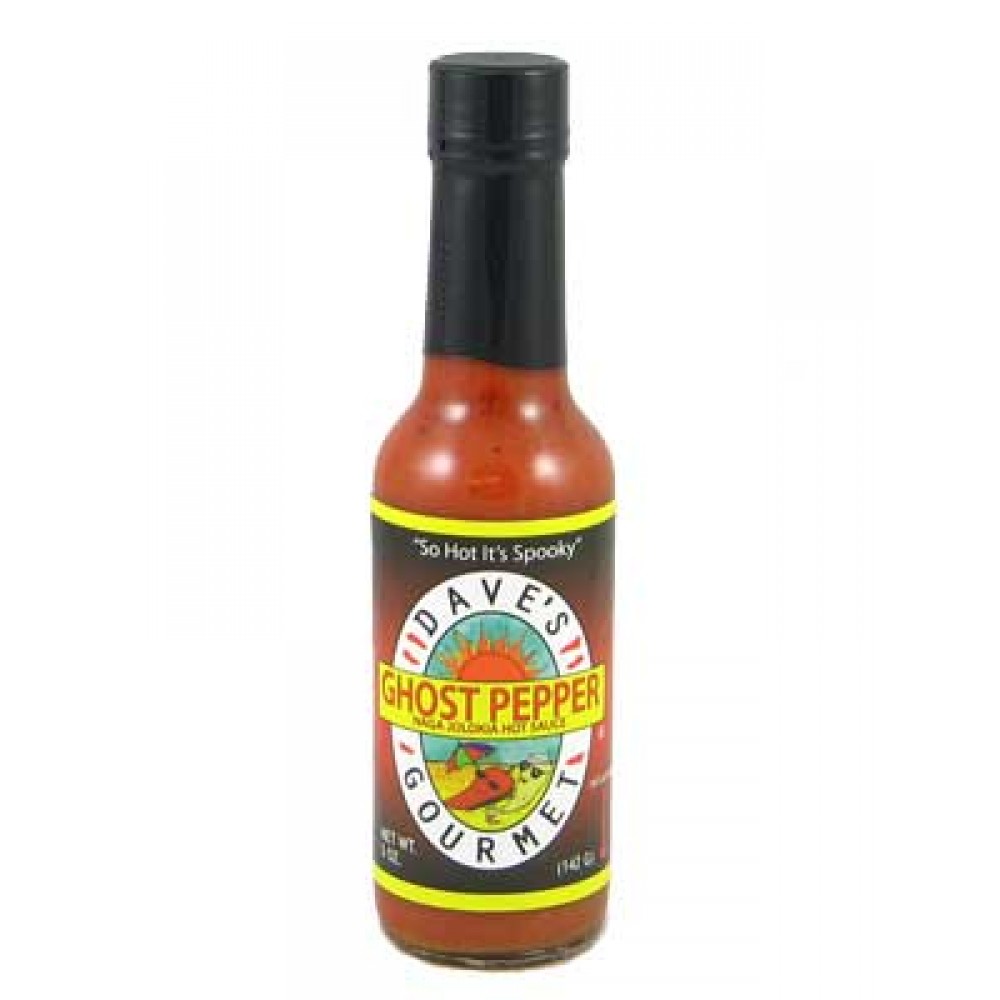

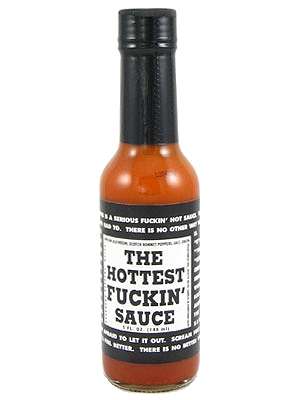





















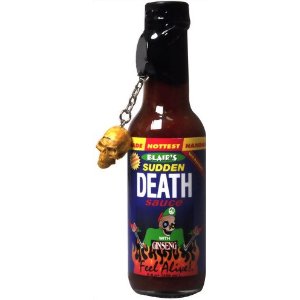





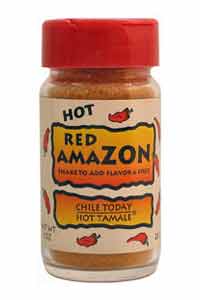

























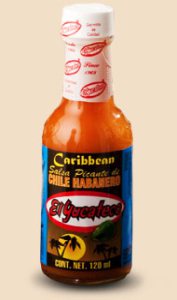

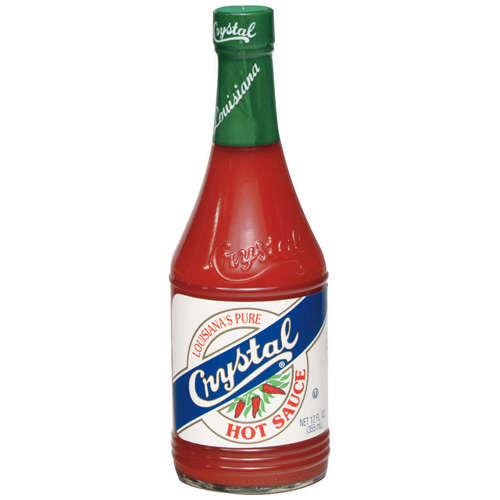

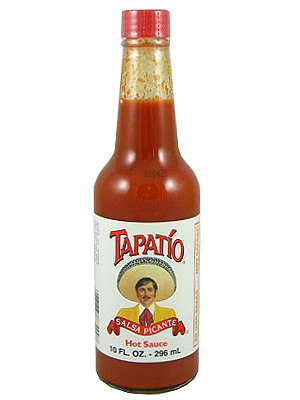




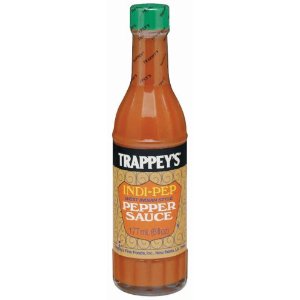
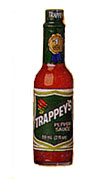






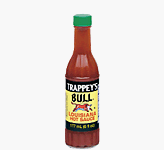
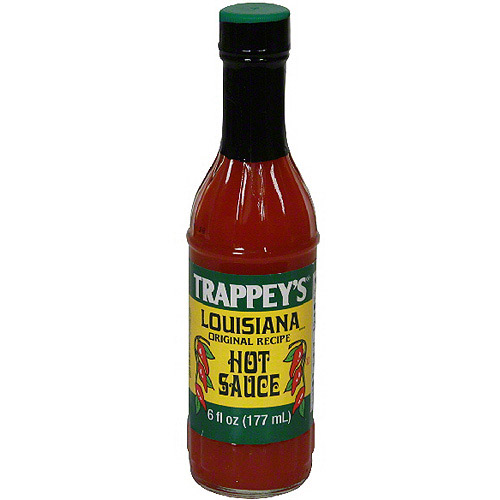
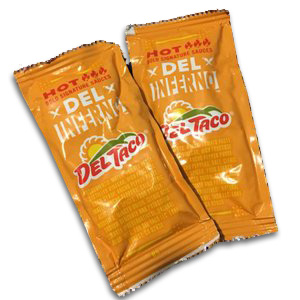
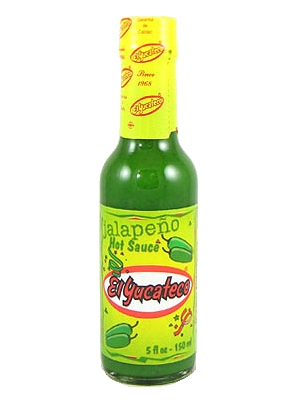


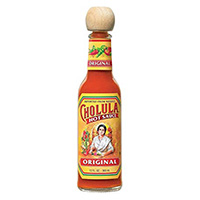

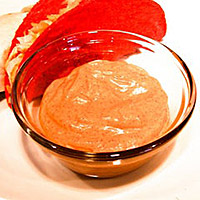

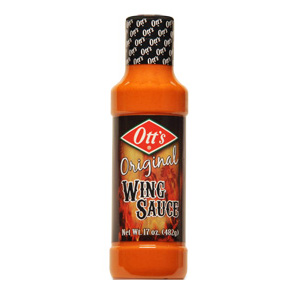


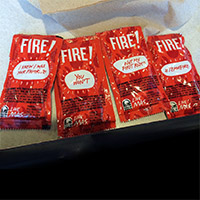

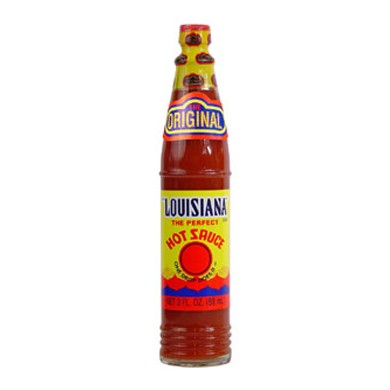

0 Comments